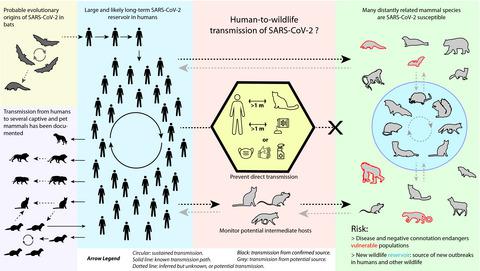当前位置:
X-MOL 学术
›
Mammal Rev.
›
论文详情
Our official English website, www.x-mol.net, welcomes your feedback! (Note: you will need to create a separate account there.)
Risk of human‐to‐wildlife transmission of SARS‐CoV‐2
Mammal Review ( IF 4.9 ) Pub Date : 2020-10-06 , DOI: 10.1111/mam.12225 Sophie Gryseels 1, 2, 3 , Luc De Bruyn 3, 4 , Ralf Gyselings 4 , Sébastien Calvignac-Spencer 5 , Fabian H Leendertz 5 , Herwig Leirs 3
Mammal Review ( IF 4.9 ) Pub Date : 2020-10-06 , DOI: 10.1111/mam.12225 Sophie Gryseels 1, 2, 3 , Luc De Bruyn 3, 4 , Ralf Gyselings 4 , Sébastien Calvignac-Spencer 5 , Fabian H Leendertz 5 , Herwig Leirs 3
Affiliation

|
Abstract It has been a long time since the world has experienced a pandemic with such a rapid devastating impact as the current COVID‐19 pandemic. The causative agent, severe acute respiratory syndrome coronavirus 2 (SARS‐CoV‐2), is unusual in that it appears capable of infecting many different mammal species. As a significant proportion of people worldwide are infected with SARS‐CoV‐2 and may spread the infection unknowingly before symptoms occur or without any symptoms ever occurring, there is a non‐negligible risk of humans spreading SARS‐CoV‐2 to wildlife, in particular to wild non‐human mammals. Because of SARS‐CoV‐2’s apparent evolutionary origins in bats and reports of humans transmitting the virus to pets and zoo animals, regulations for the prevention of human‐to‐animal transmission have so far focused mostly on these animal groups. We summarise recent studies and reports that show that a wide range of distantly related mammals are likely to be susceptible to SARS‐CoV‐2, and that susceptibility or resistance to the virus is, in general, not predictable, or only predictable to some extent, from phylogenetic proximity to known susceptible or resistant hosts. In the absence of solid evidence on the susceptibility and resistance to SARS‐CoV‐2 for each of the >6500 mammal species, we argue that sanitary precautions should be taken by humans interacting with any other mammal species in the wild. Preventing human‐to‐wildlife SARS‐CoV‐2 transmission is important to protect these animals (some of which are classed as threatened) from disease, but also to avoid establishment of novel SARS‐CoV‐2 reservoirs in wild mammals. The risk of repeated re‐infection of humans from such a wildlife reservoir could severely hamper SARS‐CoV‐2 control efforts. Activities during which direct or indirect interaction with wild mammals may occur include wildlife research, conservation activities, forestry work, pest control, management of feral populations, ecological consultancy work, management of protected areas and natural environments, wildlife tourism and wildlife rehabilitation in animal shelters. During such activities, we recommend sanitary precautions, such as physical distancing, wearing face masks and gloves, and frequent decontamination, which are very similar to regulations currently imposed to prevent transmission among humans. We further recommend active surveillance of domestic and feral animals that could act as SARS‐CoV‐2 intermediate hosts between humans and wild mammals.
中文翻译:

SARS-CoV-2 在人与野生动物之间传播的风险
摘要 世界已经很久没有经历过像当前的 COVID-19 大流行这样具有如此迅速的破坏性影响的大流行了。病原体严重急性呼吸综合征冠状病毒 2 (SARS-CoV-2) 的不同寻常之处在于它似乎能够感染许多不同的哺乳动物物种。由于全世界有很大比例的人感染了 SARS-CoV-2,并且可能在症状出现之前或没有出现任何症状的情况下不知不觉地传播感染,因此人类将 SARS-CoV-2 传播给野生动物的风险不可忽视。特别是野生非人类哺乳动物。由于 SARS-CoV-2 明显起源于蝙蝠,并且有报道称人类将病毒传播给宠物和动物园动物,因此迄今为止,预防人与动物之间传播的法规主要集中在这些动物群体上。我们总结了最近的研究和报告,这些研究和报告表明,多种远亲哺乳动物可能对 SARS-CoV-2 易感,并且对病毒的易感性或抵抗力一般来说是不可预测的,或者只能在某种程度上预测,来自与已知易感或抗性宿主的系统发育接近度。由于缺乏确凿证据证明超过 6500 种哺乳动物物种对 SARS-CoV-2 的易感性和抵抗力,我们认为人类在野外与任何其他哺乳动物物种互动时应采取卫生预防措施。防止人与野生动物之间的 SARS-CoV-2 传播对于保护这些动物(其中一些被列为受威胁动物)免受疾病非常重要,同时也可以避免在野生哺乳动物中建立新的 SARS-CoV-2 储存库。人类从此类野生动物宿主中反复感染的风险可能会严重阻碍 SARS-CoV-2 的控制工作。可能与野生哺乳动物发生直接或间接互动的活动包括野生动物研究、保护活动、林业工作、害虫防治、野生种群管理、生态咨询工作、保护区和自然环境管理、野生动物旅游和动物收容所中的野生动物康复。在此类活动中,我们建议采取卫生预防措施,例如保持身体距离、戴口罩和手套以及经常消毒,这与目前为防止人际传播而实施的规定非常相似。我们进一步建议对可能充当人类和野生哺乳动物之间 SARS-CoV-2 中间宿主的家养和野生动物进行积极监测。
更新日期:2020-10-06
中文翻译:

SARS-CoV-2 在人与野生动物之间传播的风险
摘要 世界已经很久没有经历过像当前的 COVID-19 大流行这样具有如此迅速的破坏性影响的大流行了。病原体严重急性呼吸综合征冠状病毒 2 (SARS-CoV-2) 的不同寻常之处在于它似乎能够感染许多不同的哺乳动物物种。由于全世界有很大比例的人感染了 SARS-CoV-2,并且可能在症状出现之前或没有出现任何症状的情况下不知不觉地传播感染,因此人类将 SARS-CoV-2 传播给野生动物的风险不可忽视。特别是野生非人类哺乳动物。由于 SARS-CoV-2 明显起源于蝙蝠,并且有报道称人类将病毒传播给宠物和动物园动物,因此迄今为止,预防人与动物之间传播的法规主要集中在这些动物群体上。我们总结了最近的研究和报告,这些研究和报告表明,多种远亲哺乳动物可能对 SARS-CoV-2 易感,并且对病毒的易感性或抵抗力一般来说是不可预测的,或者只能在某种程度上预测,来自与已知易感或抗性宿主的系统发育接近度。由于缺乏确凿证据证明超过 6500 种哺乳动物物种对 SARS-CoV-2 的易感性和抵抗力,我们认为人类在野外与任何其他哺乳动物物种互动时应采取卫生预防措施。防止人与野生动物之间的 SARS-CoV-2 传播对于保护这些动物(其中一些被列为受威胁动物)免受疾病非常重要,同时也可以避免在野生哺乳动物中建立新的 SARS-CoV-2 储存库。人类从此类野生动物宿主中反复感染的风险可能会严重阻碍 SARS-CoV-2 的控制工作。可能与野生哺乳动物发生直接或间接互动的活动包括野生动物研究、保护活动、林业工作、害虫防治、野生种群管理、生态咨询工作、保护区和自然环境管理、野生动物旅游和动物收容所中的野生动物康复。在此类活动中,我们建议采取卫生预防措施,例如保持身体距离、戴口罩和手套以及经常消毒,这与目前为防止人际传播而实施的规定非常相似。我们进一步建议对可能充当人类和野生哺乳动物之间 SARS-CoV-2 中间宿主的家养和野生动物进行积极监测。


























 京公网安备 11010802027423号
京公网安备 11010802027423号